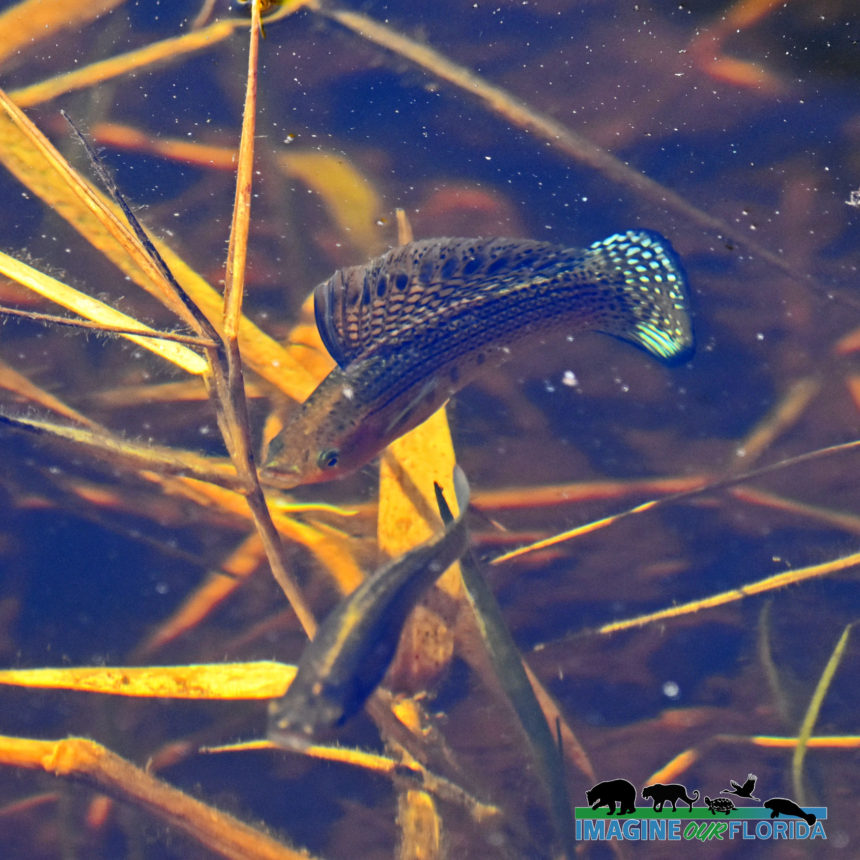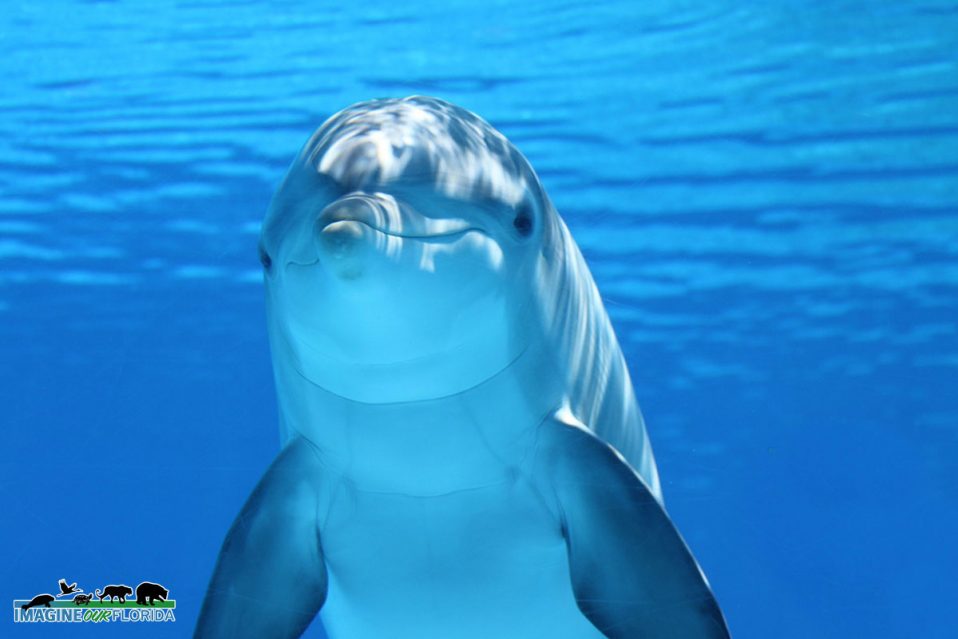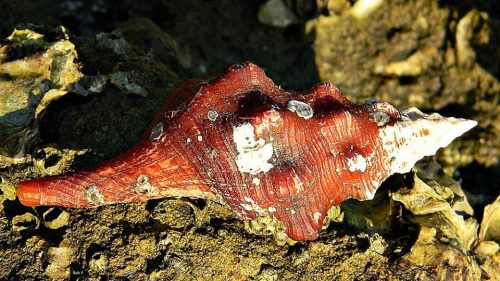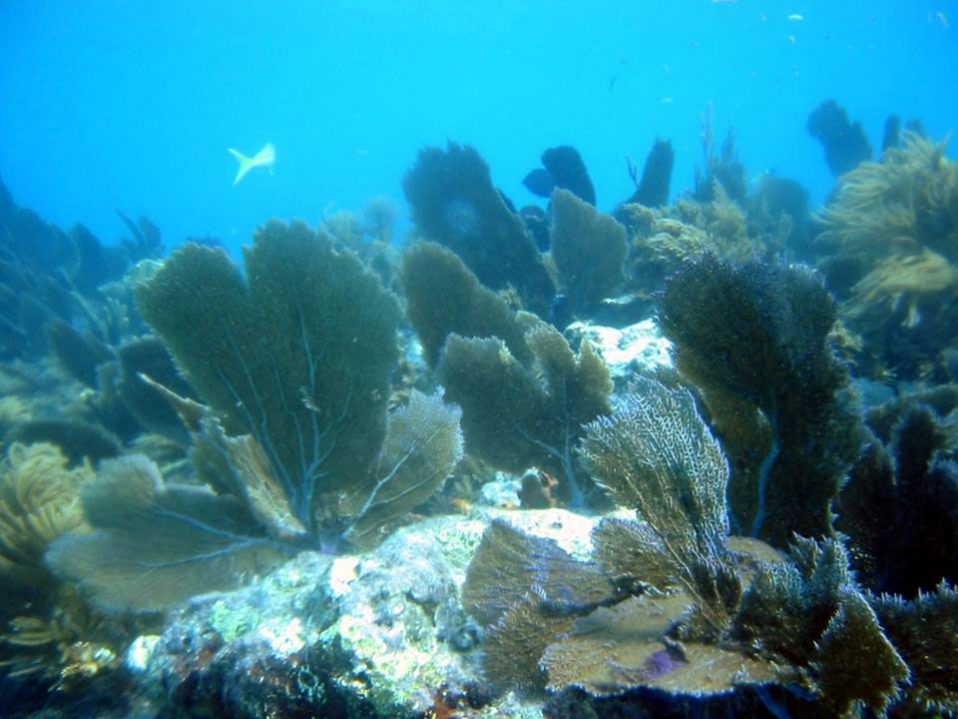Blacktip Shark
Great White Shark
Sailfin Molly
Sailfin Mollies are super cool little subtropical fish. Males have such a dramatic display with the sail-like fins. They can be found in both fresh and saltwater. Look for them in slow-moving or still freshwater in springs, swamps, creeks, ponds, in the Gulf of Mexico, and in the intercostal. They are charismatic little fish. Sailfin Mollies dine primarily on algae, and snack on crustaceans and aquatic insects.
Portuguese Man o’ War
The Portuguese man o’ war, (Physalia physalis), is a species of siphonophore that is related to jellyfish. The Man-o-war is made up of four polyps that each performs an individual function. The gas-filled polyp that floats above the water and resembles a warship is responsible for floating with the wind and currents. The tentacles capture prey while a third polyp digests the food. The fourth polyp is responsible for reproduction.
Men o’ war can be seen floating in the ocean in groups of more than 1000. Below the beautiful floats are long tentacles that measure an average of 30 feet but can grow to well over 100 feet. The tentacles paralyze and kill crustaceans and small fish who are in their path. To avoid predators, the Men o’ wars will deflate their float.
Rising ocean temperatures and reduced oxygen in the water caused by climate change have created an environment where the Men-o-war thrive. The sting from a Portuguese man o’ war causes welts and is extremely painful. When you see these beautiful creatures on the shore, admire them from afar.
Be sure to Click on the video: https://www.youtube.com/watch?v=wMYWt0nKADU
Video Credit: Claudia Pardo Merino
Bottlenose Dolphin
With their never-ending smiles, Bottlenose Dolphins (Tursiops truncatus) easily capture our hearts. These large mammals grow to lengths of 10 to 14 feet and can weigh as much as 1,100 pounds. Their powerful bodies allow them to reach speeds of over 18 miles an hour. They can live to be 50 years old.
Bottlenose Dolphins can be found inshore and offshore, including in estuaries. They are easy to spot as they surface two to three times a minute to breathe. Bottlenose Dolphins live in a community called a pod. Here they communicate with each other with an elaborate system of squeaks and whistles. Their speech allows them to work as a group to help a sick or injured dolphin, encircle a school of fish for a community dinner, and guard the pod against a shark attack.
Using echolocation, Bottlenose dolphins make 1,000 clicking noises per second. The sounds of the clicks travel through the water until it bounces off their prey. When the sound returns, the dolphin can expertly determine the shape, size, and location of their next meal. Each day an adult dolphin can eat 20 pounds of flounder, mullet, pinfish, sheepshead, and marine invertebrates.
Feeding a dolphin or swimming with a dolphin can seem harmless. It is not. In fact, it is against federal law. Human interactions with these magnificent animals can cause them to be drawn to humans, thus putting them at risk of boating accidents, entanglement in fishing nets, and consuming food that jeopardizes their health. Dolphins will pass these dangerous behaviors to their next generation. Grab a camera, and sit back and enjoy them playing and leaping in their natural, wild habitat.
Dolphin
Dolphin is a common name of aquatic mammals within the order Cetacea. Dolphins can be very large, reaching weights of up to 1400 pounds and lengths of 12.5 feet. They can live between 40 to 50 years and reach sexual maturity between 5 and 14 years.
Like all mammals, dolphins reproduce through internal fertilization, and females give birth to live young. The gestation period is between 9 to 17 months, depending on the dolphin. Juveniles are able to swim from the moment they are born, but for two years, they are dependent on their mothers for nursing.
Dolphins are thought to be some of the smartest animals on the planet. They are also extremely curious, and their intelligence is both a result and a driver of their complex social structures.
They generally live in pods between five to several hundred depending on the type of dolphin. Their preferred prey includes small, schooling fishes and squids. There are over 40 species named as dolphins, from freshwater to saltwater. Most species live in tropical and temperate oceans throughout the world. Five species live in the world’s rivers. They use echolocation to find prey and will hunt together by surrounding a school of fish, trapping them, and taking turns swimming through the school to catch the fish.
They have a vocabulary of danger sounds, food sounds, and seeking sounds. Sometimes they put these sounds together in a reasonably complex fashion. They are known to vocalize one to the other. Studies also indicate that there are differences among dolphins’ species regarding their skull size and form, variations that may lead to future changes.
As with most species today, the dolphins’ most dangerous threat is man. Sometimes, humans kill dolphins not because they are a food source but because they prey on the same fish species as humans do. Therefore, many fishermen have killed dolphins only because they are a competition for the fish. In some countries, people eat dolphins. In Japan, some species’ meat is seen as a delicacy and can cost up to $25 USD a pound. The presence of humans on Earth does not give dolphins many possibilities to survive. If they are caught in the fishing nets, they are unable to breathe and drown. There is a loss of habitat due to pollution. Millions of gallons of polluted water, toxic substances such as pesticides, heavy metals, plastic trash, and hundreds of other hazardous materials are released into the ocean and the rivers. Their habitat becomes contaminated and causes illness and death. There are many positive interactions between humans and dolphins. They have rarely attacked people. Instead, they have helped them often. The truth is that there is nothing to indicate that dolphins feel particular empathy for man since they have a highly developed social behavior. They behave the same way with other animals.
Fun Fact: While sleeping, the bottlenose dolphin shuts down only half of its brain, along with the opposite eye. The other half of the brain stays awake at a low level of alertness. The attentive side is used to watch for predators, obstacles, and other animals. It also signals when to rise to the surface for a breath of air. After about two hours, the animal will reverse this process, resting the brain’s active side and awaking the rested half. This pattern is often called cat-napping
Horse Conch
The state shell of Florida, designated in 1969., is the Horse Conch (Triplofusus giganteu). The word “conch” comes from a Greek word meaning “shell.” The Horse Conch is the largest snail found in American waters and can grow to a length of two feet. It’s easily identified by the bright orange body. The shell is grayish-white to salmon in color and covered with a brown, scaly outer layer, that you will see peeling. The 10 whorls of the shell are knobbed. Young shells are orange. The animal inside the shell is orange to brick red in color. The shell protects their soft bodies from predators. Horse Conchs use a foot that extends from their shell to drag the shell along.
Horse Conchs are commonly found in seagrass beds and reefs. This snail is carnivorous and will feed on clams and mussels as well as other snails. They consume algae and detritus (poop and parts of dead organic matter.) The female attaches capsule-like structures to rock or old shells. Each capsule contains several dozen eggs. Not all eggs are fertile. Non-fertile eggs are eaten by those who are maturing in the same capsule. When the young emerge they are an orange color and usually 3.5 inches in diameter.
Commercial harvesting requires a permit and there are limits. In some areas, it’s illegal to collect them. Lee County does not allow their harvest and Manatee county does not allow more than two per day. Keep in mind that while it may be tempting to collect large numbers of shells, other organisms rely on their shells for a safe living space after the conch dies. It’s best to admire Horse Conchs for a brief time and leave it for someone else to appreciate.
The Horse Conch’s predators are primarily humans who use them for their shells and food. Other predators are octopuses who use their suction cups to suck the conch out of its shell. Some starfish can slip one of their arms into the opening of the conch and then force their stomach out and ingest the conch right from its shell.
This photograph shows how Horse Conchs make little Horse Conchs.
Green Sea Turtle
Marine habitats surrounding the Keys provide habitat for threatened and endangered species. The Florida population of Green Sea Turtle (Chelonia mydas) has been considered endangered since 1978. The declining population has been a victim of commercial harvesting for eggs and food and incidental bycatch in the shrimp fishery. Florida is an important sea turtle nesting area. The majority of nesting in Florida occurs between May 1st and October 31st. About 90% of all sea turtle nesting in the United States occurs on Florida’s beaches. To prevent nesting and hatchling turtles from wandering off track, your beachfront property should use sea turtle-friendly lighting. Never touch a sea turtle or pick up the hatchling; it interferes with the process of imprinting on their beach.
The Green Sea Turtle has a rounded, oval body with a distinctive smaller head. Its name is derived from the greenish fat in its upper and lower shell. Incubation lasts approximately sixty days. As the nursery due date, between 4 to 5 days, comes closer, a depression forms in the sand that indicates hatchling movements. Soon, the babies begin digging out en masse to start their journey to the water’s edge. The reflection of the moonlight on the water inspires their pathway to the sea. Turtles deposit approximately 100 golf-ball-sized eggs, gently cover the eggs with sand, and then spread sand over a wide area to obscure the chamber’s exact location. A single female may nest several times during a season and then not nest again for one or two years. A male Sea Turtle never leaves the ocean. The Turtles live between 12 to 50 years. Once in the water, the hatchlings swim directly out to sea, facing a struggle to survive to adulthood. They range in size between 3 to 5 feet and weigh anywhere between 240 to 420 pounds. They mainly eat seagrass and algae, the only sea turtle that is herbivorous as an adult. Their jaws are finely serrated, which aids in tearing vegetation. The estimate is there are between 85,000 to 90,000 nesting females. It may seem like many nesting females are laying eggs, but the Green Sea Turtle is facing a high risk of extinction in the wild in the near future.
Coral Reef
—-Coral Reef—-
Florida is the only state in the continental United States with a shallow coral reef near its coast. Coral reefs create specialized habitats that provide shelter, food, and breeding sites for numerous plants and animals.
Giant Manta Ray
The Giant Manta Ray (Manta birostris) is the largest of several species of manta rays throughout the world. They can occasionally be seen here in Florida. The most commonplace to see these elegant swimmers are around coral reefs where smaller fish clean parasites collected on the rays from open waters.
Recently, an endangered species petition was proposed for three species of manta rays, including the Giant Manta Ray. Threats from illegal fishing in several countries have caused their populations to decline rapidly. They also have low reproductive rates at one pup every two years. They give live birth, but once the pup is born, there is no parental care, which reduces survival rates.
Their diet consists of plankton and very small fish. As they swim, food and oxygen from the water are filtered continuously. There is no umbilical cord, so the pups have to rely on another way of getting oxygen before they enter open waters where they can swim. They do this the same way some sharks do when they rest. It’s called buccal pumping. A small part inside their mouth pushes fluid into the mouth and past the gills. Think of it like a person gulping. Once they are born, they use a process called ram ventilation. This just means as they swim, the water passes through their gills.
Manta ray mating is really weird. It usually occurs at the reef cleaning stations. Females will release a sex hormone when they want to mate, and several males will line up to mate with her. This is referred to as “train mating” and increases the odds of fertilization.
Many places have already implemented protection for Manta Rays. Here in Florida, it is illegal to kill them under FL Administrative Code 68B-44.008. This protection has benefited not only the rays themselves but also the economy of many regions. The top 10 hot spots for giant manta rays bring in an average of $73 million in direct funds and $173 million in indirect funds. However, many areas have had such a high interest in manta rays that regulations had to be put in place so as not to disturb them.
If you are lucky enough to see one of these graceful giants here in Florida please, respect their space, don’t try to pet them, and keep your distance. If you witness anyone poaching a manta ray, you can report it to your local law enforcement or through the FWC Wildlife Alert Reward hotline; 888-404-FWCC (3922).


























Recent Comments